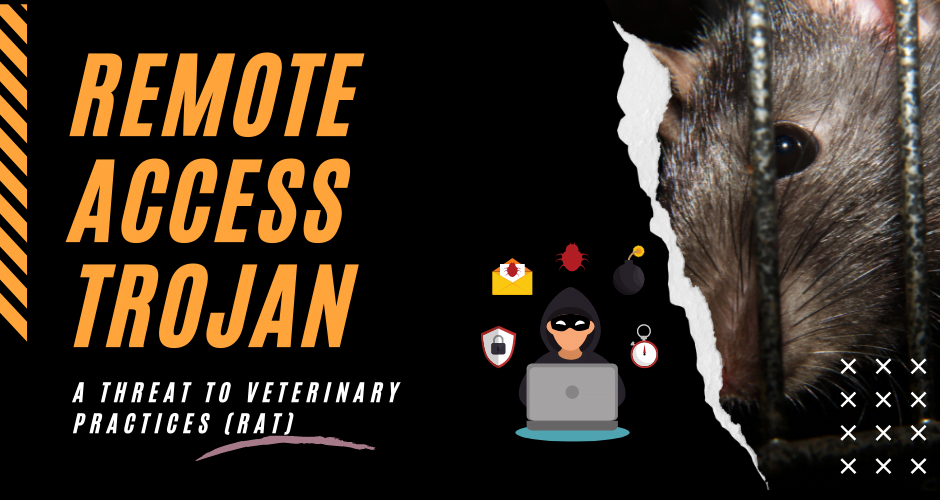
Chances are your veterinary practices will be attacked by a remote access Trojan (RAT), and you will not be able to defend yourself against the attack.
In recent years, RAT attacks have become common, and cybercriminals are increasingly using this method of attack in combination with other forms of attacks such as ransomware attacks to steal your data before encrypting your files. In this section, we are going to look at the threat of remote access Trojan to your veterinary practice and how you can avoid falling victim to such attacks.
What is remote access Trojan?
What started as a joke in the 1990s, where tech-savvy kids would remotely control their friends’ personal computers to scare them, has grown to one of the biggest cybersecurity threats in 2021.
Remote access Trojans are malicious software that, if installed on a computer allows attackers to gain unauthorized access to victims’ computers over the internet. To successfully gain access to computers, cyber attackers aim to install the RAT malware stealthily without arousing suspension from their intended targets to avoid detection.
Remote access Trojans can easily be confused with legitimate Remote Desktop Protocol applications that run legitimately on computers and help users and businesses to connect computers remotely and work remotely.
Take TeamViewer or LogMeIn applications, for instance. These two applications are able to connect two computers remotely, and users can access each other’s files and work remotely and independently over long distances. However, when applications with functionalities of TeamViewer or LogMeIn are used maliciously by cybercriminals to access unauthorized files and access computers, with the goal of compromising the system, they automatically become RATs, and the act becomes criminal.
One of the most common features of RATs is that they are able to give attackers full control of a desktop or a mobile device, allowing cybercriminals to silently browse applications and files and bypass common security features set up in the system such as firewalls and intrusion detection systems.
How remote access Trojans are used
Remote access Trojans work exactly as any other legitimate remote desktop protocol applications work. However, they are programmed to stay hidden and cybercriminals try as much as possible to operate stealthily to avoid detection.
Most RAT applications are installed together with other applications such as keyloggers and ransomware. This is because RAT malware are programmed to only perform one task of accessing unauthorized files and programs without detection. To launch an attack, cybercriminals know that they need to make use of other tools to successfully cause the intended damage to their victims.
To successfully run a remote access Trojan on users’ computers, victims need to install the program on their computer, or cybercriminals can use other methods such as phishing and malicious email attachments to force users to click on links and download and executable files.
A report released by Microsoft this month also showed that cybercriminals are now using a more complex method of attack called HTML smuggling to launch their attacks. Unfortunately for veterinary practices who may fall victim to HTML smuggling attacks, Microsoft indicated that such attacks were nearly impossible to stop because they leveraged legitimate HTML5 and JavaScript features to deploy RAT malware, which runs on all major browsers.
After gaining unauthorized access to desktops and personal computers, they are able to also gain access to authenticated accounts such as emails, veterinary practices management systems, and online banking information, which they can use to either threaten to release to the public, release to the public, or even run ransomware on the network with the aim of extorting ransom.
Can antivirus detect remote access Trojans?
RAT malware are designed to evade all security system protocols, including authentication controls, firewalls and intrusion detection systems. Therefore, the malware becomes very hard for the average user to detect. Depending on the experience of the programmers who developed the RAT malware, they may also be able to hide it from the task manager and only runs it in the background without detection.
However, in the cases where the RAT malware is not well programmed, you can be able to see their processes running on your taskbar and stopping the process from running.
In Windows, this can be done by running the netstat -ano command and looking for established connection sockets that are inconsistent with your computer settings. This process can be harder for an average user but straightforward for your cybersecurity experts.
The next step is looking at the process ID and then opening your task manager to locate the process and stop it by right-clicking on the process and selecting the end process tab.
How to get rid of remote access Trojan
Your veterinary practice may not be equipped with tech-savvy individuals who can manually track down remote access Trojans on your computer and stop them from operating in your practice’s computer systems.
In such cases, you need to get high-quality antivirus/anti-trojan software that is able to detect, track down, isolate and destroy any type of trojan installed on your computer. The antivirus/anti-trojan software can also come in handy when you need a faster detection system to avoid being caught unaware by cybercriminals using RAT malware.
As a veterinary practice, it is advisable to always have antivirus/anti-trojan software installed on your network to avoid such attacks.
